Its day 210 of the lockdown in South Africa, extraordinary times. I have been pondering about Tito Mboweni’s forthcoming medium-term budget. He and his team have an impossible task to present any form of coherent, believable financial plan for the country. Neal Froneman, the enigmatic CEO of Sibanye-Stillwater, was rather forthright in his interview with Alec Hogg on BizNews earlier this week stating that South Africa is bankrupt. Well I guess it depends on your definition of bankrupt. If it means that you have to keep borrowing to pay the bills, then bankrupt you are. Disturbingly, Froneman stated that Sibanye-Stillwater would not be investing any more capital into South Africa for the foreseeable future. He mentioned that it would be a disservice to Sibanye-Stillwater’s shareholders to invest capital in an investor unfriendly environment such as South Africa. Perhaps it is time for the ANC to realize that South Africa is one of many investment destinations competing for global capital.
I downloaded the Global Social Mobility Report 2020 published by the World Economic Forum earlier this year. I thought it would be interesting to review how South Africa compared to other countries in terms of various social and economic metrics. It proved to be a fascinating exercise and slightly depressing. There are truly some international backwaters. How about the Central African Republic, a landlocked country in the middle of the continent. It has the highest deaths from infectious diseases (894 per 100,000 population) and traffic accidents amongst all countries covered by the WEF report. Also, 86% of residents of the Central African Republic use unsafe or unimproved water sources. I suppose it could be worse – 92% of Madagascar residents use unsafe or unimproved sanitation.
Given that South Africa may seem first world compared to some African backwaters, I decided to restrict my analysis to the 82 countries listed in the James Gwartney, Robert Lawson, Joshua Hall, and Ryan Murphy (2020) Economic Freedom of the World 2020 Annual Report published by the Fraser Institute. I have taken the liberty of extracting data from both the Fraser Institute and WEF reports to expand the analysis.
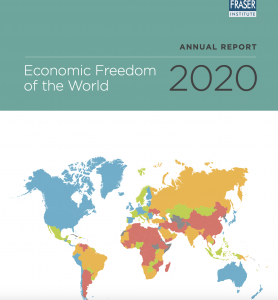
I did not expect the WEF report to include South Africa’s astonishing victory in the 2019 World Cup rugby tournament – we are currently proudly ranked number 1 in the world in this sport. I suspected that we would not do so well in equality and employment statistics. Before I delve into some interesting stats, a quick pop quiz:
- Which country has the highest GDP per capita? is it United States, Switzerland or Luxembourg?
- Which country has lowest income Gini score? In other words, which country has the most income equality? Is it Denmark, Iceland or Ukraine?
- Which country has the worst access to justice? Is it El Salvador, Russia or Turkey?
Answers to the above questions will become evident later in this blog post.Given the COVID-19 pandemic, or rather the lockdown hysteria, let’s start with infectious diseases. Unfortunately, South Africa’s track record here is not great.
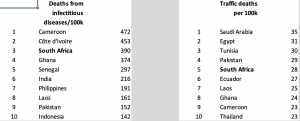
To put the above stat into perspective, South Africa has of 21 October 2020, had ±32 deaths per 100,000 population from COVID-19 versus 390 per 100,000 from infectious diseases in 2018 per the WEF report. It transpires that South Africans are not that good on the road but who would have thought that Saudi Arabia would have the highest traffic deaths per capita? It may be all that low cost fuel up North?
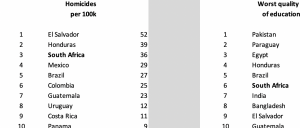
I am afraid our scorecards are not that great in homicides and education. It is frightening to think that South Africa may have more murders per capita in a year than from COVID-19 related deaths. I am tempted to digress into “death from” COVID to “death with” COVID to excess deaths according to the SAMRC. I will exercise discipline and stick to the analysis at hand and leave the PANDA people to fight that good fight.
The interesting thing about our education ranking is that it would appear that our education (public) system is very poor in comparison to global standards yet our throughput is quite good – 77% of our kids make it to secondary school. Enough said, its could be worse – only 6% of kids reach high school in Chad! On a positive note, South Africa ranks highly in terms of mobile phone subscriptions – it seems we like to jabber on the phone and send WhatsApp messages. According to the WEF data, South Africans on average have 1.6 subscriptions each. My goodness, that’s a lot. Well I suppose Gigaba may need at least 3 phones given his alleged mistresses and the content of some of his WhatsApp messages.
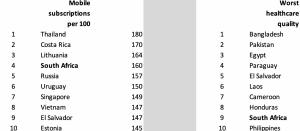
We know that our public healthcare system is in a shambles. No surprise that we are ranked the 9th worst healthcare system amongst those covered by the Fraser Institute report. And the ANC wants to introduce NHI. According to Leon Louw of the Free Market Foundation, “…the NHI, after all, is fraudulently named – it entails prohibition of health insurance…”. I am not sure where National Treasury or the ANC is going to find the money to fund the NHI. Hopefully, this is yet another pipe dream of the ANC which will never see the light of day. Education and healthcare are very real problems in South Africa and we need solutions. We just don’t need the ANC’s solutions. They are very good at deflecting from the real issues and practical solutions to these problems. Ok, let’s highlight one of those real issues and that’s income inequality. South Africa is ranked the most unequal society on the planet from an income perspective. That is tragic and a massive generational problem. The WEF estimates that it may take 9 generations in South Africa for low income families to reach mean income levels of the greater population.
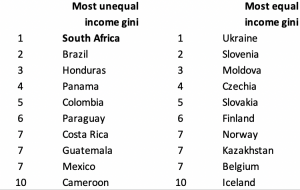
You may have noticed that the Ukraine is the most equal society from an income perspective. That may not reflect reality since Ukrainians are very poor generally, with GDP per capita of US$2,964 per the WEF. So everyone is equally poor. By the way, the highest GDP per capita per WEF is currently Luxembourg at US$114,234 – which is ±18 times South Africa’s average.
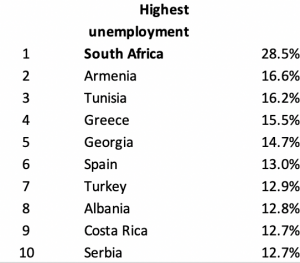 Unfortunately, South Africa also has the highest unemployment rate of the countries surveyed. The above 28.5% unemployment is from 2018 data from the World Bank. A further estimated 2.2 million jobs have been lost since lockdown and our unemployment may well be higher than StatsSA’s current estimate of 42% on an expanded basis. Nic Spaull, who spearheads the Nids-Cram National Income Dynamics Study, estimates that there are currently 14.3 million people employed in South Africa versus 16.5 million unemployed. I am too terrified to ask him what youth unemployment rates are.
Unfortunately, South Africa also has the highest unemployment rate of the countries surveyed. The above 28.5% unemployment is from 2018 data from the World Bank. A further estimated 2.2 million jobs have been lost since lockdown and our unemployment may well be higher than StatsSA’s current estimate of 42% on an expanded basis. Nic Spaull, who spearheads the Nids-Cram National Income Dynamics Study, estimates that there are currently 14.3 million people employed in South Africa versus 16.5 million unemployed. I am too terrified to ask him what youth unemployment rates are.
I am afraid that South Africa’s scorecard is looking bleak at present. We have some incredible mineral reserves. We have the ability to generate so much clean energy. We have some of the most scenic beauty known to mankind. Our weather is conducive to all year round tourism. We have some incredible innovators and entrepreneurs. It is just a pity about our government who are flailing from fantasy to ideological solutions. What South Africa needs now, is a unified approach to tackling unemployment, education and healthcare. The private sector has demonstrated that is can solve the latter two. The ANC should listen carefully to business about solving the jobs crisis.
Stay safe and be kind. All the best from BeechieB.
PS Turkey is regarded as the country with the least access to justice.

Recent Comments